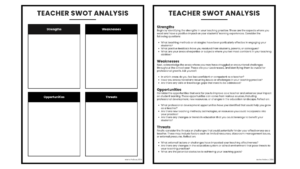
As we all know, teachers are leaving the classroom in droves. They’re losing their teaching spark, which is heartbreaking considering that teaching is a calling, passion, and impactful work.
A lot of recent articles are blaming the pandemic for this upheaval of teacher resignations. But I think that COVID was just the straw that broke the camel’s back.
We can’t blame COVID protocols for what teachers have to deal with at schools and districts where leadership is managerial and lackluster.
Having had the experience of working as a classroom teacher at various districts, public and private schools, and in different parts of the country, I have first hand knowledge of how school leadership can affect a teacher’s mental health and self-efficacy.
I’ve seen the reasons why teachers feel undervalued, micromanaged, and unheard.
Here are the three things that are happening to teachers across the country due to poor leadership:
1. Observations with No Purpose
Walkthroughs and observations are important. As a classroom teacher, I want to grow professionally and be the best for my students. I am a lifelong learner and I know I can always be better.
I have had opportunities to be observed by influential administrators who have made me the teacher I am today, but sadly, teachers are being bombarded with administrators who just walk in for that “I gotcha” moment. These administrators would rather see their teachers stuck in an anxiety ridden moment, not an uplifting one.
My most memorable walkthroughs were ones where I found positive notes of affirmation, uplifting comments about my classroom management, and smiles and affirming nods. Unfortunately, teachers also remember times when administrators have made them feel insignificant, lackluster, or afraid. That is not the purpose of walkthroughs. An administrator is there to lift up and support their staff, which in turn will support the students.
2. Misuse of Data and Assessments
Assessments and data are extremely valuable when used appropriately and effectively. I was the assessment coordinator for the state department of education, so I know how important data is for our classrooms. It guides our instruction, provides insight on our students’ progress, and helps us make informed decisions about our classroom practices. When we can be vulnerable about our data and share teaching practices, it helps our students soar.
But when data is used to vilify teachers, then we have an issue! At some school sites, data is used to make teachers feel inadequate. Rather than looking at the makeup of the class, student demographics, or students’ social emotional and behavioral needs, everything is blamed on the teacher.
Data should also be used to inform the district of their curriculum choices. For example, if a school is using a math curriculum and making the teachers stick to the script, slides, or pacing guide, and their math scores are not improving, then is it the teacher’s fault or the curriculum’s fault? If teachers aren’t allowed to interpret data and suggest ideas for improved instruction, while collaborating with the administrators, then students won’t succeed.
Assessments play an extremely important role in instruction as well. Assessments should be reliable and tied to the learning goal. As a teacher, when I was able to create assessments with my grade level team and use them to create intervention plans and guide instruction, our students were the ones who won. Adversely, when teachers are tied to assessments that don’t align with the standards or learning goals, then how can we guide our instruction?
Administrators, both district and school, need to be open to hearing new ideas and working collaboratively as a team with their teachers.
3. Because We’ve Always Done It This Way
Teachers are tired of hearing the most dangerous phrase in education: Because we’ve always done it this way. Education is always changing. That’s the only constant, right?
Districts who continue to use a curriculum because it’s what they’ve always used, or continue to use certain assessments because it’s what they’re used to, are not truly meeting students where they are at and they are not providing effective instruction or practices in their classrooms. District and school administrators who are focused on the past will never move forward.
It’s time for school administrators to support their teachers and for district administrators to support their principals.
We cannot continue to have teachers leave because they feel unsupported.
So, what can we do about it?
Just like there are many districts and schools around the country doing what I outlined above, there are also districts and schools who are implementing their practices effectively and supporting teachers.
Here’s what successful school leaders have done to make teachers feel heard and supported:
Implement Observations with Purpose and Clear Expectations
Observations shouldn’t be meant to be an “I gotcha” moment for teachers. Observations should be an opportunity for teachers and administrators to collaborate to improve teaching practices.
Common practice for an effective observation is to have a pre-observation to discuss the lesson and the teacher’s goals. Administrators should communicate what they’re looking for and teachers should communicate their goals and what specific elements they want their administrator to observe. During the observation, the administrator should take notes of what the teacher did during the lesson and pay specific attention to the elements they and the teacher discussed during their pre-observation meeting. Feedback after the observation should be given immediately. It should be effective feedback that is objective and can help the teacher be better at their practice.
If administrators are doing unannounced walkthroughs, they should leave effective feedback immediately, in the form of notes or something electronically. Administrators can be objective by commenting on what they saw, what they heard, and what they wonder about the lesson. To take it a step further, administrators can let teachers know at the start of the week or the day that they’ll be walking through classrooms during specific times. For instance, during the math hour looking for evidence of math talk. The point is to communicate and make sure teachers are aware of what is being observed and in what areas they’ll receive feedback.
Properly Use Data and Assessments
The use of data and assessments greatly improves instruction when done correctly. It is important to be intentional when choosing assessments. District and school leaders should choose assessments that align with standards and learning goals that can inform instruction.
If assessments are dated or not aligned with current standards, then they’re pointless. Giving an assessment to check off boxes because the district office has certain contracts with companies is not a good use of instructional time and it won’t help to plan future instruction.
District leaders need to be intentional and open minded when asking their school leaders to use specific assessments for benchmarks or other purposes. We do not want to over assess our students! When thinking about data and assessments we need to ask ourselves:
- What do we want all students to know and be able to do?
- How will we know if they learn it?
- How will we respond when some students do not learn?
- How will we extend the learning for students who are already proficient?
Stop Doing Things “Because We’ve Always Done It This Way”
As researcher John Hattie says, almost everything in education works- However, we need to do what works most effectively. If what districts have been doing for years is not effective, then they need to change it. District and school leaders should be willing to recognize when practices are outdated or ineffective and they should be open to new ideas.
Overall, it’s important for school leaders to be cognizant of what teachers are going through in classrooms today. Students are entering our schools with behavioral and social emotional needs that need to be met. Administrators can support their teachers with this by just being a listening ear, going into the classroom with a supportive mindset and not a punitive one, and by acknowledging teachers’ struggles. Most importantly, school leaders need to stay up to date with current research and best educational practices that have a high impact on student learning which in turn will assist teachers in the classroom. Ultimately, the goal should be to effectively support teachers and do what is best for students.




